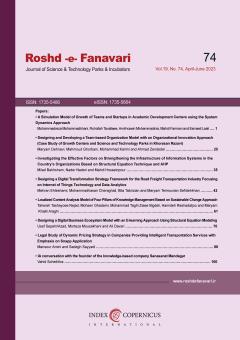-
-
List of Articles
-
Open Access Article
1 - A Simulation Model of Growth of Teams and Startups in Academic Development Centers using the System Dynamics Approach
Mohammadreza Mohamadkhani Ruhollah Tavallaei Amirhossein Mohammadinia mahdi farmani Esmail laali -
Open Access Article
2 - Designing and Developing a Team-based Organization Model with an Organizational Innovation Approach (Case Study of Growth Centers and Science and Technology Parks in Khorasan Razavi)
maryam dehnavi Mahmoud , Ghorbani Mohammad Karimi Ahmad zendedel -
Open Access Article
3 - Investigating the Effective Factors on Strengthening the Infrastructure of Information Systems in the Country's Organizations Based on Structural Equation Technique and AHP
Vahid Hajilo zahra moghimi -
Open Access Article
4 - Designing a Digital Transformation Strategy Framework for the Road Freight Transportation Industry Focusing on Internet of Things Technology and Data Analytics
Mehran Ehteshami Mohammad Hasan Cheraghali Bita Tabrizian Maryam Teimourian sefidehkhan -
Open Access Article
5 - Localized Content Analysis Model of Four Pillars of Knowledge Management Based on Sustainable Change Approach
Tahereh TashayoieNejad Mohsen Ghadami Mohammad Taghi Ziae Bigdeli hamide reshadatjoo Maryam Khaliliaraghi -
Open Access Article
6 - Designing a Digital Business Ecosystem Model with an E-learning Approach Using Structural Equation Modeling
usef sepehriazad morteza mosakhani Ali Davari -
Open Access Article
7 - Legal Study of Dynamic Pricing Strategy in Companies Providing Intelligent Transportation Services with Emphasis on Snapp Application
Mansour Amini Sadegh Sayyadi
-
The rights to this website are owned by the Raimag Press Management System.
Copyright © 2017-2025







